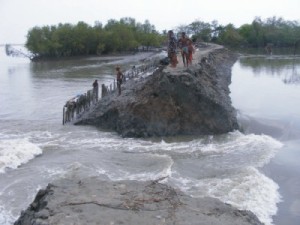Climate change is the greatest environmental challenge facing the world today. Human induced changes in the global climate and associated sea level rise are widely accepted with policy makers and scientists. The Intergovernmental Panel on Climate Change (IPCC) concluded that “the balance of evidence suggests a discernible human influence on global climate”. Rising global temperatures due to climate change will bring changes in weather patterns, rising sea levels and increased frequency and intensity of extreme weather events. Climate change poses significant risks for Bangladesh. The exact magnitude of the changes in the global climate is still uncertain and subject of worldwide scientific studies. It is broadly recognised that Bangladesh is very vulnerable to these changes. Indeed, it has internationally been argued that Bangladesh, as a country, may suffer the most severe impacts from climate change. A new report called Climate of Disaster, published this month in Bali by Tearfund shows that, based on past experience, Bangladesh is going to continue to be one of the worst-hit places on the planet.
Scientists tell us that the most profoundly damaging impact of climate change in Bangladesh will take form in floods, salinity intrusion and droughts, all of which will drastically affect crop productivity and food security. We will also face riverbank erosion, sea water level rise and lack of fresh water in the coastal zones. The prognosis is more extreme floods in a country already devastated by floods; less food for our country in which half our children already don’t have enough to eat; and less clean water for where waterborne diseases are already responsible for 24 percent of all deaths. Bangladesh is one of the world’s largest deltas, formed by a dense network of 230 unstable rivers; most of the country is less than 10 meters above sea level. Were the Earth to warm by just one degree Celsius, 11 percent of Bangladesh would be submerged, putting the lives of 55 million people in danger. Most scientists — including the UK government’s David King — expect a two-degree increase. It is almost impossible to imagine how Bangladesh will cope with this situation.
Climate refers to the average weather experienced over a long period. This includes temperature, wind and rainfall patterns. The climate of the Earth is not static, and has changed many times in response to a variety of natural causes. Climate change represents a change in the long-term weather patterns. When scientists talk about the issue of climate change, their concern is about global warming caused by human activities. Global warming refers to an average increase in the Earth’s temperature, which in turn causes changes in climate. A warmer Earth may lead to changes in rainfall patterns, a rise in sea level, and a wide range of impacts on plants, wildlife, and humans.
The main human influence on global climate is emission of the key greenhouse gases — carbon dioxide (CO2), methane and nitrous oxide. The accumulation of these gases in the atmosphere strengthens the greenhouse effect. At present, just over 7 billion tones of CO2 is emitted globally each year through fossil fuel use, and an additional 1.6 billion tones are emitted by land use change, largely by deforestation. Due to greenhouse impact global temperature is increasing with increased amount of CO2 in the atmosphere. The Earth’s average surface temperature has been risen by 0.76° C since 1850. Over the last 16,000 years, the rate of increase in global temperatures has been about 1°C for every 4,000 years — and yet, some predictions now suggest that we may see another 1° increase over the next one hundred years. In its Fourth Assessment Report (AR4), published on 2 February 2007, the Intergovernmental Panel on Climate Change (IPCC) projects that, without further action to reduce greenhouse gas emissions, the global average surface temperature is likely to rise by a further 1.8-4.0°C this century.
This will result in a further rise in global sea levels of between 20 and 60cm by the end of this century, continued melting of ice caps, glaciers and sea ice, changes in rainfall patterns and intensification of tropical cyclones. Scientists examined the number of tropical cyclones and cyclone days as well as tropical cyclone intensity over the past 35 years, in an environment of increasing sea surface temperature. A large increase was seen in the number and proportion of hurricanes reaching categories 4 and 5. The largest increase occurred in the North Pacific, Indian, and Southwest Pacific Oceans, and the smallest percentage increase occurred in the North Atlantic Ocean.
Recently Sidr has battered Bangladesh. It is believed that natural calamities like Sidr and other types of cyclone is the output of the phenomenon as the world climate is changing fast because of global warming caused by anthropogenic pollution. Long vulnerable to nature’s fury, Bangladesh stands to suffer even more from extreme weather events like this as a result of human-induced climate change, scientists say. Cyclone, Sidr and Tsunami are the outcome of climate change for which industrialised nations are responsible. A number of rich nations are yet to implement the agreement of Kyoto Protocol of 1997.
Climate change is a global issue that demands a global response. All countries must be part of the solution. Speaking at the UN Climate Change Conference in Bali, (COP13) Andy Atkins, Tearfund’s Advocacy Director says: “It is time for the international community to take stronger action to support vulnerable communities’ efforts to reduce the risk of disaster. Airlifting stranded people from floodwaters and sending food packages to those affected by drought can no longer be our sole response to weather-related disasters. As a global community we have a moral responsibility to invest our aid money upfront in helping the planet’s poorest people prepare for predictable disaster. If we do not, then many thousands of lives will be needlessly lost and billions of pounds of aid money will not be used to best effect.”
Bangladesh, one of the most densely populated countries in the world, with over 755 people per square Km, has a per capita income of only about US$235. Over 40 percent of the population lives in poverty. With its high population density, low level of development, and low lying deltaic mass, Bangladesh has already been facing a number of natural and man made problems. Natural hazards like cyclones, floods, droughts and socio-economic problems such as poverty, low literacy, poor health delivery systems, high unemployment are some of them. In future Bangladesh may also have to face adverse impact of climate change and sea level rise. To better prepare the country for dealing with these impacts pragmatic planning is needed based on authentic data and analyses from scientific studies.
Author : Mirza Galib, Lecturer, Primeasia University.



































